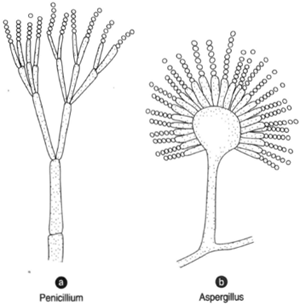Penicillium and Aspergillus
 |
| Figure 19-8 (a) Penicillium and (b) Aspergillus. |
Penicillium and Aspergillus are widespread bluea nd green molds that grow on decaying fruits, vegetables, jellies,a nd preserves. Because ascus formation has been observedi n very few species, many mycologists classt@he se forms inth e taxonomic catchall of Fungi Imperfecti. Some mycologists, however, relegate them to Ascomycetes. Only conidiophore formation is discussed following.
In Aspergillus, the apex of a sporangiophore develops bau lbous swelling, from the surface of which large numbers of short branches extend. Conidiospores are pinched off at the ends of these branches. The microscopic appearance of the conidiophores, with their chains of spores, reminded an observer of an aspergillum (a device resembling a perforated globe on a short handle and used in sprinkling holy water): thus the name.
One species of Aspergillus is used to convert sugar to citric acid, a substance used in flavoring. Aspergillus is also used to produce gallic acid (used in the manufacture of dyes and indelible black ink) and to make soy sauce.
In Penicillium, the conidiophore divides to form two or more branches, each of which terminates in a chain of conidia. The Latin word penicillium, meaning “little brush,” is the basis of the genus name. Penicillium cumemberti and Penicillium ruquefortii are well known for their effect on cheese. The great fame of Penicillium, however, relates to the discovery of the antibiotic penicillin, which came originally from P. crysogenum. British microbiologist and physician Alexander Fleming first discovered penicillin in 1928, when he noted the inability of bacteria to grow in a culture medium close to a contaminant of the Penicillium mold. It was not until 1940 that the drug was isolated in pure form and its promise to medicine was demonstrated. By that time, the exigencies of war made large-scale production of the new “wonder drug” of supreme importance. A team of British and United States workers began by culturing the original mold; the amount of penicillin that could be extracted was extremely small and the cost was very great, however. The team thus appealed to the public to send material that had become moldy with greenish or bluish mold. Garbage flowed to them from all over the country. In a short time, the team had a mold, found on a spoiled cantaloupe, that would produce twenty-five times more penicillin than could be obtained from the original culture. They were next successful in finding a strain that yielded eighty times the original amount. Eventually, by the use of x-radiation techniques, molds were cultured that yielded 225 times the original culture. By D-Day, when allied forces invaded France on the coast of Normandy, enough penicillin had been obtained to treat several million patients. It was an enormous undertaking.




